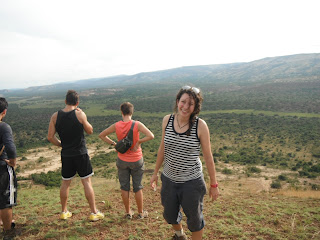This story begins with a woman sitting on a long, plain,
wooden bench in an ordinary room in Kayanga town. The room was once painted a
yellow-tan color but has since been decorated in scuffs, scratches, and dirt.
The paint is rubbed off in places, and the ceiling is home to handfuls of
wasps, migrating from their main colony to smaller ones near by. The woman sits
with her feet firmly on the concrete floor, her back to a wooden door latched
with a silver and gold padlock. She, like many women from across the Karagwe
District of North-Western Tanzania, has travelled from her home and family to
sit in this room. The room is plain, unremarkable. But it is in this room that
women are heard. This room, at WOMEDA, is where she has come to share her story
and to get help.
WOMEDA,
Women Emancipation and Development Agency, is a non-profit organization
dedicated to assisting and supporting women with regards to legal rights and
gender equality in the community. The woman of our story sits in the WOMEDA
office, facing the social counselor who is tucked in behind her desk. The desk
is by far the liveliest object in the room. It is a rich brown wooden desk
overflowing with papers, folders, and notebooks, some of which spill onto the
floor. The keyboard is pushed to the side, and the computer is covered by
stacks and files. By its posture, it is clear that it is the least important of
the desk’s occupants. The counselor shifts some of these piles to reveal a
phone, keys, a stapler, 3 boxes of staples, and the WOMEDA official stamp with
purple ink. Once she is prepared with pen and paper to document the session,
the woman on the bench shifts forward, elbows on her knees, and begins her
story with a name, age, marital status, number of kids. As she exhales and
allows herself to open up to another woman, her story develops and brings to
life struggles, hardships, and inequalities as well as beauty, strength, and
passion. The burden of these truths overwhelm her and she glances away, towards
the single window in the room, covered by pink and orange curtains patterned
with flowers and bamboo. She takes another breath to steady herself, but her
tears betray her. “Don’t cry. How can they take you seriously if you are crying?”
the social counselor gently insists before they work their way towards determining
the best action plan for this particular client. Maybe she is given a letter to
summon her husband into the office, or a referral to the tribunal in her ward. Either
way, a plan is set in action to change the woman’s circumstance. It might be a
long road, but at WOMEDA she has finally been given a voice. With that voice,
and through sharing her story, she has been given hope for progress.
At WOMEDA, telling one’s own story is essential to addressing
the problem at hand, whether that is a marital, family, land rights, or legal
case. The exchange of stories as a means of learning about and understanding
our new community is also a recurring theme in my personal growth and in our
group of Amizade students. As a temporary member of the WOMEDA community, I am
privileged with the opportunity to sit and listen to counseling sessions, meet
women from around the district, and hear their stories. I chose to share the
story of WOMEDA—an organization that gives thousands of women a voice—with you
in hopes of encouraging a ripple effect of awareness that simply begins with a
compelling story but has the power to initiate and support progress and change.
To view the other students' entries:
http://amizade.org/volunteer/tanzania-spring-semester/?submit=view





































